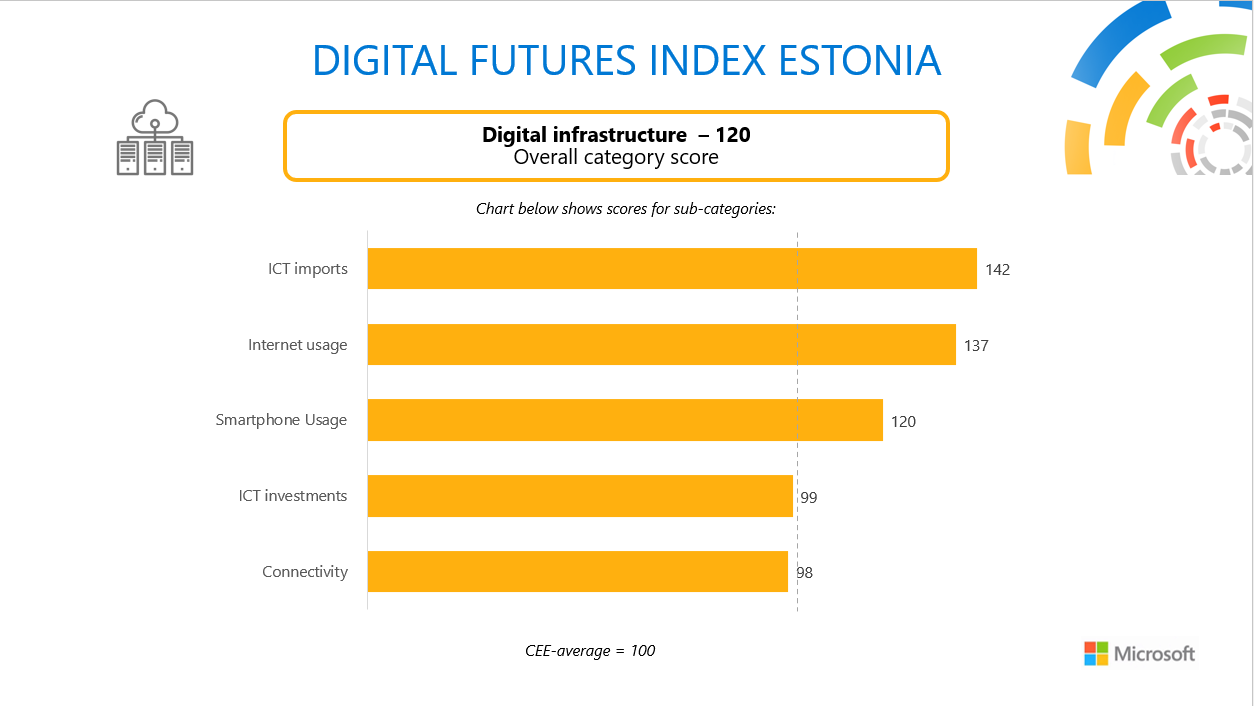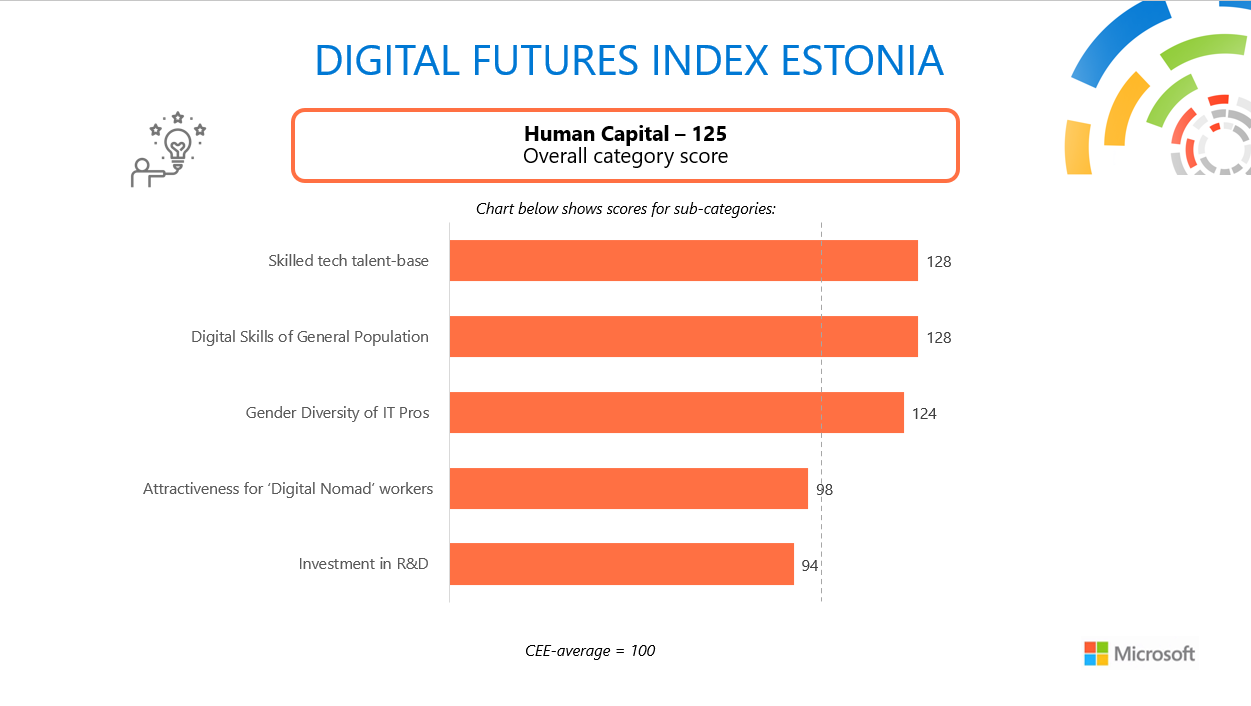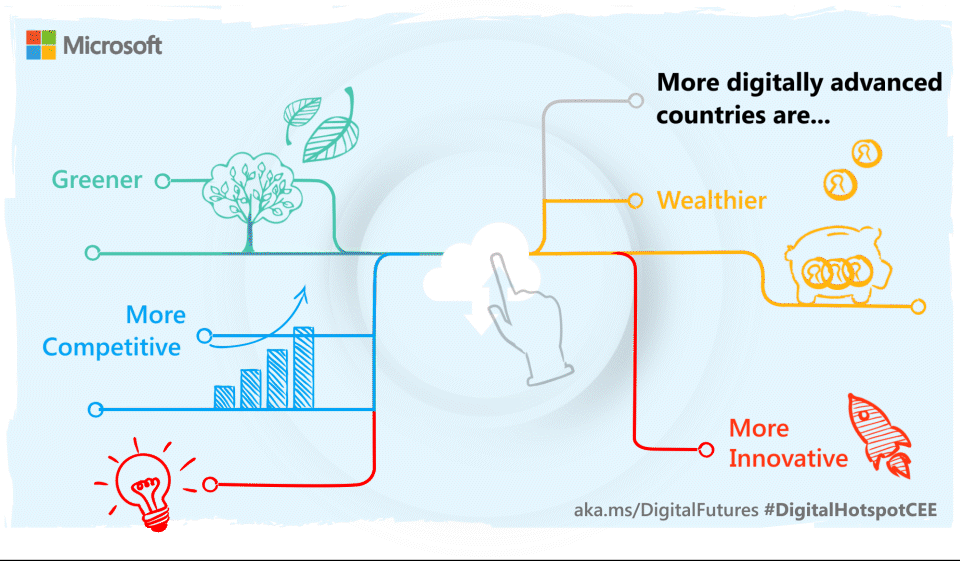Estonia is considered to be the global leader in e-governance, digital transformation, and technologies. However, we still need to continue investing in tech talents and education.
Microsoft created the Digital Futures Index and measured the digitalization level of 16 European countries, including Estonia. The index provides data on the current level of digitalization of the country, detects the most successful areas, but also areas that need to be focused on to accelerate the process of digital transformation.
Digitization is observed through five categories of digital development: digital business, digital government and public sector, digital infrastructure, digital sector, and human capital. The overall level of digital development in Estonia is 139, which is 39 percent above the average of Central and Eastern European countries (100 is the number of points defined as the average for CEE). Estonia outperforms all countries in the Index when it comes to digital public services. It scores very highly on cloud usage, remote working, employment of ICT specialists, and more – demonstrating key strengths across all categories of digital development in the Index. Estonia has the highest number of start-ups per capita compared to other countries in scope. Estonia is recognized as a leader in eGovernment and outperforms CEE countries in digital development overall. With the right investments and policies, we are primed to catch up with the digital frontrunners.
“We’ve created Digital Futures Index to help decision makers to accelerate digital transformation. Although Estonia has great results, main priorities to further advance digitalization are investing in tech talent, enhancing joint private and public investments in digital infrastructure and continuing development of public and private digital services. Our research has shown that digitally advanced countries are greener, richer, more innovative, and more competitive – and we in Microsoft see Estonia becoming a digital hub that will base its economic growth on innovations and the latest technologies, like artificial intelligence,” commented Vaida Sapole, Country Manager, Microsoft Baltics.
Results of the Digital Futures Index for Estonia by category, related to the average of CEE countries (100 marks the average)
- In the digital business category Estonia scored 128 points, 28 percent above CEE average. Estonian business scores highly on digital competitiveness. However, for the percentage of companies that employ ICT specialists Estonia scored only 75, and total computer software spending is 20% below the CEE-average.

- In the category of digital government and public sector Estonia achieved 134 points, 34 percent above the average. Estonia has the highest level of public interaction with government via digital technology. The one area where Estonia is slightly behind is in education – it is 13% below for the percentage of teachers with the skills needed to integrate e-learning into the curriculum.

- In the area of digital infrastructure Estonia gained 120 points. In Estonia public sector plays an important role through delivering digital public services that encourage people to be digitally active.

- In the category of human capital – 125 points. Estonia scores highly on both nurturing future tech talent and the digital skills of its population. frontrunners. The country is 6% below average for private investment in research and development, and it also scores 88 of the % of graduates who study STEM, so there is still space for progress.

- The best results are in the digital sector category – 144 points, 44% above the CEE average. Start-up sector does well to attract venture capital, scoring 137. Estonia scores at a similar level to digital frontrunner countries on the percentage of ICT-specialists of total employment. However, it underperforms on the percentage of companies who employ ICT-specialists. This suggests a divide between companies that have heavily invested in tech talent, and those who have not.

Digitization helps businesses become more innovative and productive. But investing in technology isn’t enough to be successful if companies don’t also prioritize digital skills, digital-first leadership and hybrid working culture. Estonia had above-average levels of remote working even before the pandemic – suggesting we are well positioned to embrace hybrid working moving forward.
About the Digital Futures Index
Digital Futures Index is using highly credible public data sources to map digital development along a wide range of parameters. It was designed to model digital development and explore its relationship with societal and economic advancement. The Index includes data for the following CEE countries: Croatia, Czech Republic, Estonia, Hungary, Greece, Malta, Poland, Romania, Russia, Serbia, Slovenia. To obtain additional data for comparison, it also includes a select group of advanced ‘benchmark’ Western Europe countries, which are digital frontrunner nations: Denmark, Finland, Netherlands, Sweden; and Portugal, which is on the digital rise.
Microsoft continues with its mission to empower every person on the planet to achieve more.
More regionally relevant articles can be found at CEE Multi-Country News Center.
Digital Futures Index PowerBI you can research via link aka.ms/DigitalFuturesIndex.
Note: Digital Futures Index is not a rating, it measures a “digital pulse” of every country.





